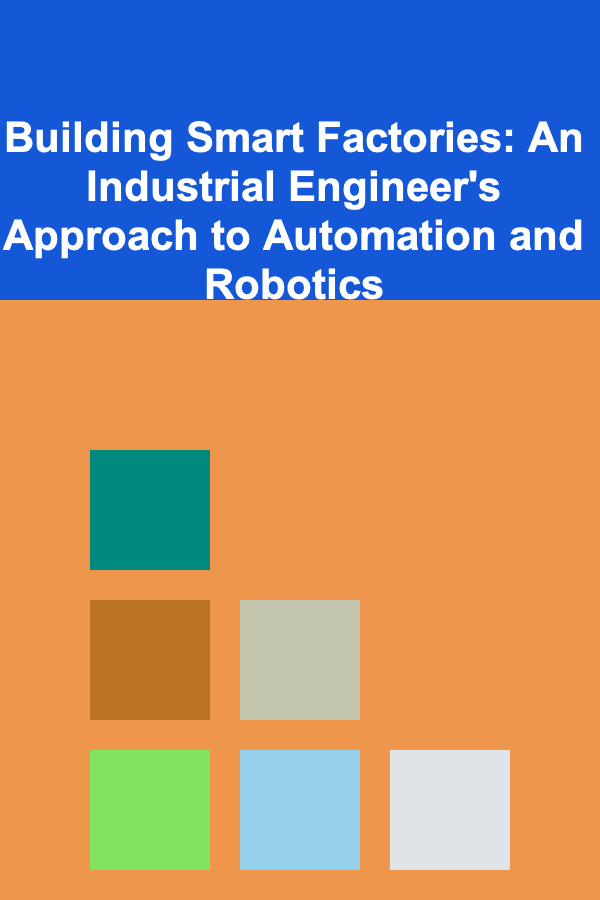
Building Smart Factories: An Industrial Engineer's Approach to Automation and Robotics
ebook include PDF & Audio bundle (Micro Guide)
$12.99$10.99
Limited Time Offer! Order within the next:

In today's competitive manufacturing landscape, the concept of smart factories is rapidly evolving. The integration of automation and robotics is transforming traditional manufacturing environments, enabling businesses to enhance productivity, reduce costs, and improve quality. As industries push toward Industry 4.0, industrial engineers are at the forefront of this transformation, leading efforts to build smart factories that can adapt to changing demands, maximize efficiency, and drive innovation.
This actionable guide explores the role of industrial engineers in building smart factories, providing a deep dive into the application of automation and robotics, the technologies involved, and the strategies required to successfully implement these advancements.
Understanding the Concept of Smart Factories
A smart factory is an advanced manufacturing facility where digital technologies, automation, and data analytics work together to optimize production processes. These factories are characterized by their ability to make real-time decisions, self-optimize, and adapt to changing production needs without requiring human intervention.
Smart factories rely on interconnected systems that collect and analyze data, offering real-time visibility into every aspect of the manufacturing process. This connected ecosystem not only improves the efficiency and flexibility of operations but also enhances product quality, reduces waste, and minimizes downtime.
The key components of a smart factory include:
- Internet of Things (IoT) devices to collect data from machines and sensors.
- Robotics and automation to perform repetitive or complex tasks.
- Artificial intelligence (AI) and machine learning (ML) for predictive analytics and real-time decision-making.
- Cloud computing to store and process vast amounts of data from all connected devices.
- Cyber-physical systems (CPS) that integrate physical processes with digital technologies for continuous monitoring and control.
The Role of Industrial Engineers in Building Smart Factories
Industrial engineers play a crucial role in the design, implementation, and optimization of smart factories. They apply their knowledge of systems, processes, and optimization to ensure that automation and robotics are integrated in a way that maximizes efficiency and quality. Their responsibilities often include:
- Analyzing production processes: Identifying opportunities for automation and process optimization.
- Designing automated systems: Developing systems that integrate robotics, sensors, and AI to improve production.
- Implementing control systems: Creating feedback loops that allow systems to adjust in real-time based on data.
- Optimizing workflows: Redesigning layouts and processes to reduce bottlenecks and improve the flow of materials.
- Managing change: Leading the transition to smart factory operations, ensuring that employees are trained and systems are aligned with business goals.
Industrial engineers combine their expertise in process optimization, ergonomics, and systems thinking to ensure that every component of a smart factory operates in harmony.
Key Technologies Driving Smart Factories
1. Robotics: Transforming Manufacturing with Precision
Robotics plays a pivotal role in the development of smart factories. From simple pick-and-place robots to advanced robotic arms capable of performing complex assembly tasks, robotics can significantly enhance production efficiency. These systems are designed to automate repetitive, labor-intensive, and precise tasks, reducing human error and improving throughput.
- Collaborative robots (Cobots): Unlike traditional robots, cobots work alongside human operators, assisting them in tasks that require precision and heavy lifting. These robots are designed with safety features, making them an ideal solution for flexible, small-batch production lines.
- Autonomous Mobile Robots (AMRs): These robots are used to move materials, components, and products across the factory floor. AMRs can navigate independently, avoiding obstacles and optimizing the flow of goods within the facility.
- Industrial robots: These are typically used for repetitive tasks such as welding, packaging, and assembling products. They are programmed to perform precise movements with high speed and accuracy, ensuring consistency and reducing cycle times.
2. Automation: Streamlining Operations
Automation encompasses the use of technology to control and monitor various manufacturing processes without human intervention. The rise of Industrial Automation Systems (IAS) is a fundamental component in building smart factories. Automation systems rely on sensors, actuators, and control systems to manage tasks such as temperature regulation, machine operations, and material handling.
Key components of automation include:
- Programmable Logic Controllers (PLCs): These are industrial computers used to automate control systems in manufacturing processes. They provide real-time feedback and can trigger specific actions based on predefined conditions.
- SCADA systems (Supervisory Control and Data Acquisition): SCADA systems provide centralized control and monitoring of factory operations. They collect data from sensors across the factory floor, enabling operators to monitor processes remotely and make adjustments as needed.
- Automated Guided Vehicles (AGVs): AGVs are used to transport materials throughout the factory, eliminating the need for human-driven forklifts and reducing the potential for accidents.
3. Artificial Intelligence and Machine Learning: Smarter Decision Making
Artificial intelligence (AI) and machine learning (ML) are transforming smart factories by enabling predictive analytics, real-time decision-making, and process optimization. AI algorithms can analyze vast amounts of data collected from sensors, machines, and robots, providing insights that lead to more efficient production strategies.
- Predictive Maintenance: AI can predict when a machine is likely to fail, enabling maintenance teams to address issues before they cause downtime. This reduces unplanned maintenance costs and maximizes equipment uptime.
- Demand Forecasting: AI can analyze historical data to predict future product demand. By incorporating this information into production schedules, manufacturers can better align production capacity with market needs.
- Process Optimization: Machine learning algorithms can identify inefficiencies in production processes and suggest improvements, such as adjusting machine speeds or reconfiguring workflows to reduce cycle times.
4. Internet of Things (IoT): Connecting Everything
The Internet of Things (IoT) enables smart factories by connecting all devices, machines, and systems in the factory to a network, allowing them to communicate with each other and share data. Sensors embedded in machines and products can collect data on temperature, pressure, vibration, and other critical variables, enabling real-time monitoring and feedback.
Benefits of IoT in smart factories include:
- Real-time monitoring: Continuous data collection from sensors provides operators with up-to-date insights into machine performance, product quality, and environmental conditions.
- Data-driven decisions: IoT enables manufacturers to make data-driven decisions that optimize processes, reduce waste, and improve efficiency.
- Remote control and maintenance: With IoT-enabled devices, operators can remotely monitor and control systems, as well as perform diagnostics and troubleshooting without having to be physically present on the factory floor.
5. Cloud Computing: Managing and Analyzing Big Data
Cloud computing enables manufacturers to store and process large volumes of data collected from the factory floor. This data can be analyzed using advanced analytics and machine learning algorithms to improve decision-making and optimize manufacturing processes.
Benefits of cloud computing in smart factories include:
- Scalability: Cloud platforms can easily scale to accommodate the growing data needs of smart factories, ensuring that data storage and processing capabilities remain flexible.
- Collaboration: Cloud computing allows teams across different locations to access and collaborate on data, fostering better communication and knowledge-sharing.
- Cost-effectiveness: By using cloud infrastructure, manufacturers can avoid the capital expenses associated with maintaining on-premise servers and computing resources.
Strategies for Implementing Automation and Robotics
1. Conduct a Feasibility Study
Before implementing automation and robotics, industrial engineers must conduct a comprehensive feasibility study to determine the potential benefits, costs, and risks associated with the adoption of new technologies. This study should assess the following:
- Current production capabilities and limitations.
- Potential for process improvement and cost reduction.
- ROI estimation and timeline for payback.
- Compatibility of new technologies with existing systems.
2. Start with Pilot Projects
For many companies, implementing automation and robotics can be a significant undertaking. To mitigate risks, industrial engineers often recommend starting with pilot projects. These smaller-scale initiatives allow manufacturers to test new technologies in a controlled environment, assess their impact on production, and identify potential challenges before scaling up.
3. Integrate Systems for Seamless Operations
Building a smart factory requires the integration of various systems, including automation, robotics, AI, and IoT devices. Industrial engineers play a vital role in ensuring these systems work together seamlessly. They must design systems that communicate effectively and share data across platforms to ensure smooth and continuous operations.
4. Train the Workforce
The successful implementation of automation and robotics depends on the workforce's ability to operate and maintain new technologies. Industrial engineers must work with HR and training departments to develop programs that help employees acquire the necessary skills to interact with automated systems and robots. Continuous training is essential for ensuring that workers are equipped to handle evolving technologies.
5. Monitor and Optimize Continuously
Even after the implementation of automation and robotics, industrial engineers must continuously monitor the performance of these systems. Through data analysis, they can identify areas for further optimization, troubleshoot any issues that arise, and ensure that the factory continues to operate at peak efficiency.
Conclusion
Building smart factories is a complex, yet rewarding endeavor for industrial engineers. By leveraging automation, robotics, AI, IoT, and other cutting-edge technologies, engineers can help manufacturers achieve unprecedented levels of efficiency, flexibility, and quality. As factories become more intelligent and interconnected, industrial engineers will continue to play a pivotal role in shaping the future of manufacturing.
Through careful planning, integration, and continuous optimization, industrial engineers can ensure that smart factories are not only technologically advanced but also optimized for long-term success.
Reading More From Our Other Websites
- [Home Cleaning 101] How to Tackle Common Cleaning Mistakes and Avoid Damage
- [Home Maintenance 101] How to Make Energy-Efficient Home Upgrades and Save on Bills
- [Home Space Saving 101] How to Save Space in Your Bedroom with Smart Furniture Choices
- [Organization Tip 101] How to Declutter Your Home in 30 Days
- [Personal Finance Management 101] How to Teach Kids About Money Management
- [Personal Care Tips 101] How to Apply Sunscreen for Maximum Effectiveness in the Sun
- [Personal Care Tips 101] How to Use Facial Cleanser to Help Prevent Breakouts
- [Organization Tip 101] How to Use Carts for Mobile Laundry Storage
- [Stamp Making Tip 101] Troubleshooting Common Rubber Stamp Issues: Ink Bleed, Durability, and Clean-Up Hacks
- [Organization Tip 101] How to Maintain Your Walk-in Shower for Long-lasting Beauty and Functionality

How to Make Money Online as a Marketing Coordinator: 10 Actionable Ideas
Read More
How to Maximize Your Savings with High-Interest Accounts
Read More
How to Store Art Supplies for Easy Access
Read More
How to Use a Capsule Wardrobe for Closet Simplification
Read More
How to Master Event-Driven Programming
Read More
How to Develop VR for Retail Experiences
Read MoreOther Products

How to Make Money Online as a Marketing Coordinator: 10 Actionable Ideas
Read More
How to Maximize Your Savings with High-Interest Accounts
Read More
How to Store Art Supplies for Easy Access
Read More
How to Use a Capsule Wardrobe for Closet Simplification
Read More
How to Master Event-Driven Programming
Read More